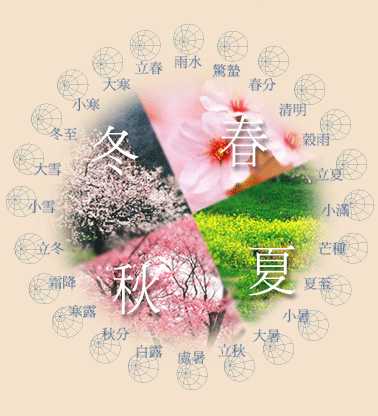|
|

|
| The Twenty-four Solar Terms |
???????古代一組節令的總稱,即自立春至大寒共二十四個節氣,以表征一年中天文、季節、氣候與農業生產的關系。它是中國古代獨特的創造。作為一部完整的農業氣候歷,在指導中國農業生產上發揮了較大作用,沿用至今。
???????In the ancient times, there was a general name for a group of seasons, i.e. the Twenty-four Solar Terms from the Beginning of Spring to Great Cold. It shows the relationship between universe, season, climate and agriculture, which is unique creation by Chinese ancestors. To date, it has functioned as a complete set of weather calendar to guide the agricultural production in China.
???????二十四節氣的形成和發展與中國農業生產的發展緊密相連。農業發展初期,由于播種和收獲等農事活動的需要,開始探索農業生產的季節規律,出現了春種、夏長、秋收、冬藏的概念。春秋戰國以后隨著鐵制農具的出現,農業生產對季節性的要求更高了,就逐漸形成了節氣的概念。春秋時已用土圭測日影定節氣。最初只有夏至、冬至,隨后逐漸增加了春分、秋分及立春、立夏、立秋、立冬。
???????The Twenty-four Solar Terms come to being and develop in close relationship with Chinese agricultural production. At the initial stage of agricultural development, people began to explore the seasonal rule in the agricultural production to meet the needs in seeding, harvesting and other activities. Gradually, there formed the concept of "Seed in Spring, Grow in Summer, Harvest in Autumn and Store in Winter". During the Spring and Autumn Period (770-476 BC), the agricultural production was highly subject to the seasonal changes with the invention of iron tools, thus forming the concept of Solar Term. At that time, the method of tugui was used to measure the shadow of the sun for determining the solar terms. Initially, there were only the Summer Solstice and the Winter Solstice. Later added were the Spring Equinox, the Autumnal Equinox, the Beginning of Spring, the Beginning of Summer, the Beginning of Autumn and the Beginning of Winter.
???????二十四節氣在天文學上是以視太陽在黃道上的位置來確定的。以黃經0°為春分,以下每15°為一節氣,周天為360°而成二十四節氣。二十四節氣后傳入朝鮮、日本等鄰國。日本在江戶時代(1603~1867)開始采用,并傳至今日。
???????Astronomically, the Twenty-four Solar Terms are defined according to the position of the sun on the ecliptic. 0 degree of celestial longitude is the Spring Equinox and the every solar term matches the passage 15 degrees. As a result, there come Twenty-four Solar Terms as it passes by 360 degrees. Later, the Twenty-four Solar Terms were introduced into North Korea, Japan and other neighboring countries. During the Edo Period (1603-1867), Japan began to adopt the Twenty-four Solar Terms, which have been used till now.
???????立春 the Beginning of Spring (1st solar term February 3-5)
???????雨水 Rain Water (2nd solar term February 18-20)
???????驚蟄 the Waking of Insects (3rd solar term March 5-7)
???????春分 the Spring Equinox (4th solar term March 20-22)
???????清明 Pure Brightness (5th solar term April 4-6)
???????谷雨 Grain Rain (6th solar term April 19-21)
???????立夏 the Beginning of Summer (7th solar term May 5-7)
???????小滿 Grain Full (8th solar term May 20-22)
???????芒種 Grain in Ear (9th solar term June 5-7)
???????夏至 the Summer Solstice (10th solar term June 21-22)
???????小暑 Slight Heat (11th solar term July 6-8)
???????大暑 Great Heat (12th solar term July 22-24)
???????立秋 the Beginning of Autumn (13th solar term August 7-9)
???????處暑 the Limit of Heat (14th solar term August 22-24)
???????白露 White Dew (15th solar term September 7-9)
???????秋分 the Autumnal Equinox (16th solar term September 22-24)
???????寒露 Cold Dew (17th solar term October 8-9)
???????霜降 Frost's Descent (18th solar term October 23-24)
???????立冬 the Beginning of Winter (19th solar term November 7-8)
???????小雪 Slight Snow (20th solar term November 22-23)
???????大雪 Great Snow (21st solar term December 6-8)
???????冬至 the Winter Solstice (22nd solar term December 21-23)
???????小寒 Slight Cold (23rd solar term January 5-7)
???????大寒 Great Cold (24th solar term January 20-21)
(China.org.cn April 25, 2011) |

